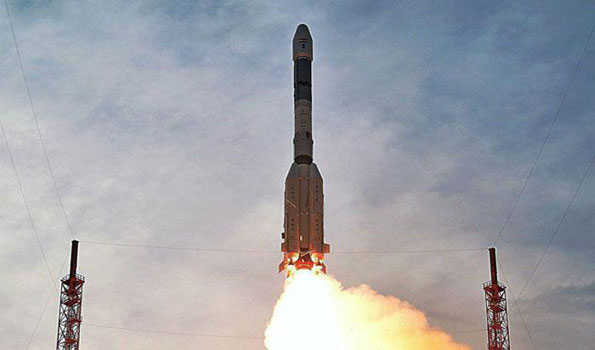New vista in space communications opens: ISRO’s copybook launch of GSAT 6A
Sriharikota, Mar 29 : Heralding a new era in space communications, India on Thursday successfully launched its latest satellite GSAT 6A, a technology demonstrator, offering high power transponders with multi beam coverage.
The satellite was injected into geosynchronous transfer orbit by GSLV-F08, nearly 18 minutes after a copybook launch from the Satish Dhawan Space Centre here.
It was the 12th launch in the GSLV series and the sixth flight using indigenous cryogenic engine.
The 49.1 metre tall launch vehicle blasted off at 1656 hrs after a successful 27-hour countdown, during which various operations were carried out by the mission coordinators under the watchful eyes of senior Indian Space Research Organisation officials, and scientists, including ISRO chairman Dr K Sivan.
In the following days, controllers at the Master Control facility in Hassan, Karnataka, would carry out three orbit raising maneuvers using it’s on board propulsion systems to take the satellite closer to its intended space home of 83 deg east longitude at a height of 36,000 km.
Similar to GSAT-6, a high power S-band communication satellite with a mission life of 10 years, GSAT 6A would provide mobile communication for the country through multi beam coverage facility (S band five spot beams and C band one beam).
The satellite will also provide a platform for developing technologies such as demonstration of 6 m S-Band Unfurlable Antenna, handheld ground terminals and network management techniques that could be useful in satellite based mobile communication applications. It would provide 3119 w of power.
GSLV-F08 was an improved version when compared to its predecessors. The second stage was powered by a new high thrust Vikas engine and instead of electro-hydraulic actuation system in the second stage, an electro mechanical actuation system was used.
The launcher hurled into geosynchronous transfer orbit communication satellite GSAT6A, 17 minutes 46.5 seconds after the blast off. At the time of separation, the satellite was at a perigee of 170 km and apogee of 35,975 km with an inclination of 20.63 degrees.
A beaming Dr K Sivan, who tasted his first success after taking over as chairman of ISRO, said the successful launch would herald a new era for the nation’s space programme.
He said the satellite was injected into geosynchronous transfer orbit at the desired level precisely. Along with GSAT 6, it will be a platform to develop advanced technologies.
Dr Sivan said that the successful trajectory of the improved version GSLV would enable ISRO to take up launch of three tonne category satellites.
(UNI)


Comments are closed.